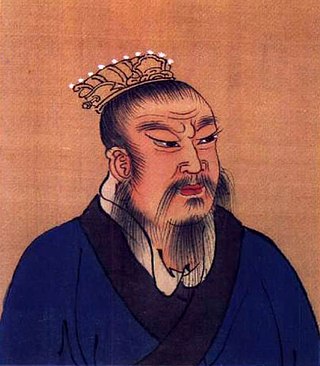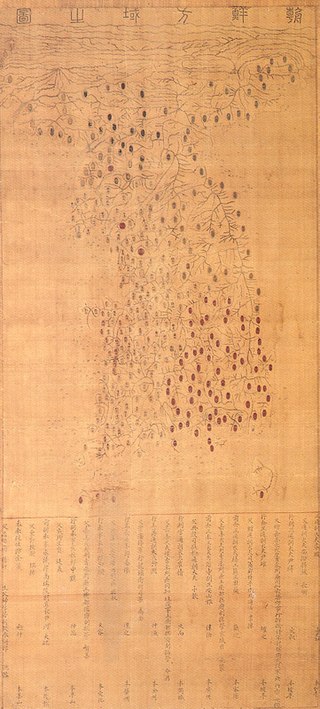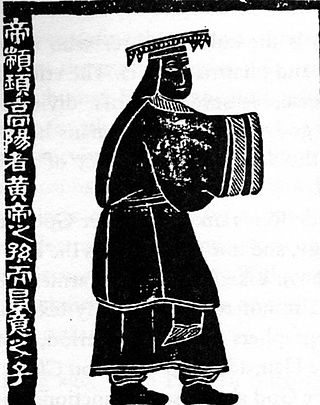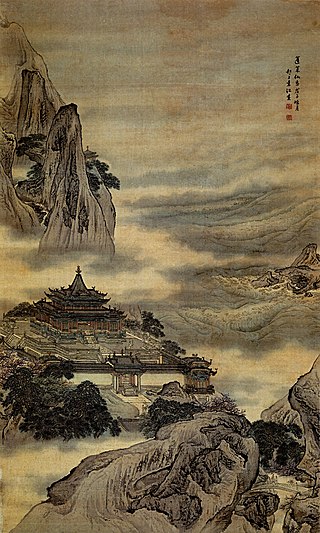
Han Xiangzi, courtesy name Qingfu or Beizhu, is a Chinese mythological figure and one of the Eight Immortals in the Taoist pantheon. He studied Taoist magical arts under the tutelage of Lü Dongbin, another of the Eight Immortals. Han Xiangzi is often depicted carrying a dizi, so he is also regarded as the patron deity of flutists. He is also believed to be the composer of the Taoist musical piece Tian Hua Yin (天花引).

The Yellow Turban Rebellion, alternatively translated as the Yellow Scarves Rebellion, was a peasant revolt during the late Eastern Han dynasty of ancient China. The uprising broke out in c. March 184 CE, during the reign of Emperor Ling. Although the main rebellion was suppressed by 185 CE, it took 21 years for full suppression of resistant areas and emerging rebellions by 205 CE. The weakening of the imperial court and the rising political influence of ultra-autonomous regional military-governors, who helped suppress the rebellion, eventually led to rampant warlord dominance and the resultant Three Kingdoms period.

The Summer Palace is a vast ensemble of lakes, gardens and palaces in Beijing. It was an imperial garden in the Qing dynasty. Inside includes Longevity Hill Kunming Lake and Seventeen Hole Bridge. It covers an expanse of 2.9 square kilometres (1.1 sq mi), three-quarters of which is water.
Zhifu Island or North Island, is an islet with historical significance in Shandong Province, China. The name of the islet Chefoo was generalized to mean the entire Yantai region in older western literature.

Emperor Gaozu of Han, courtesy name Ji (季), was the founder and first emperor of the Han dynasty, reigning 202–195 BC. His temple name was "Taizu" while his posthumous name was Emperor Gao, or Gaodi; "Gaozu of Han", derived from the Records of the Grand Historian, is the common way of referring to this sovereign even though he was not accorded the temple name "Gaozu", which literally means "High Founder".

Ye or Dongye, which means the Eastern Ye, was a Korean chiefdom which occupied portions of the northeastern Korean peninsula from roughly 3rd-century BC to around early 5th-century AD. It bordered Goguryeo and Okjeo to the north, Jinhan to the south, and China's Lelang Commandery to the west. Today, this territory consists of the provinces of South Hamgyŏng and Kangwon in North Korea, and Gangwon in South Korea.

The ruan is a traditional Chinese plucked string instrument. It is a lute with a fretted neck, a circular body, and four strings. Its four strings were formerly made of silk but since the 20th century they have been made of steel. The modern ruan has 24 frets with 12 semitones on each string, which has greatly expanded its range from a previous 13 frets. The frets are commonly made of ivory or in recent times of metal mounted on wood. The metal frets produce a brighter tone as compared to the ivory frets. It is sometimes called ruanqin, particularly in Taiwan.

Zhuanxu, also known as Gaoyang, was a mythological emperor of ancient China.

Kunming Lake is the central lake on the grounds of the Summer Palace in Haidian District, Beijing, China. Together with the Longevity Hill, Kunming Lake forms the key landscape features of the Summer Palace gardens.

Tian Feng, courtesy name Yuanhao, was a Chinese politician serving under the warlord Yuan Shao during the late Eastern Han dynasty.

The burning of books and burying of scholars, also known as burning the books and executing the ru scholars, refers to the purported burning of texts in 213 BCE and live burial of 460 Confucian scholars in 212 BCE by the Chinese emperor Qin Shi Huang of the Qin dynasty. This was alleged to have destroyed philosophical treatises of the Hundred Schools of Thought, with the goal of strengthening the official Qin governing philosophy of Legalism.

Penglai is a legendary land of Chinese mythology. It is known in Japanese mythology as Hōrai.
Meng Yi was a Chinese military general and politician. As an official of the Qin dynasty, he served in the court of Qin Shi Huang. He was a younger brother of the general Meng Tian. After Qin Shi Huang's death, Meng Yi and his brother were executed by Qin Er Shi on the urging of Zhao Gao.
Fangshi were Chinese technical specialists who flourished from the third century BCE to the fifth century CE. English translations of fangshi include alchemist, astrologer, diviner, exorcist, geomancer, doctor, magician, monk, mystic, necromancer, occultist, omenologist, physician, physiognomist, technician, technologist, thaumaturge, and wizard.

Ao is a large marine turtle in Chinese mythology. He was thought to have lived in the South China Sea during the time of the formation of the world. When the goddess Nüwa, creator of mankind, was repairing the sky after a disaster, she chopped off Ao's four legs and used them as supports.
Zhang Yang, courtesy name Zhishu, was a Chinese politician and warlord who lived during the late Eastern Han dynasty of China. Originally from Yunzhong Commandery in the north, he eventually became the de facto ruler of Henei Commandery. A brave and lenient man, Zhang Yang would provide refuge for Emperor Xian of Han and be involved in court politics, eventually attaining the rank of Grand Marshal (大司馬). Seeking to help an old friend, he would be assassinated by a subordinate.

The Wǔfāng Shàngdì, or simply Wǔdì or Wǔshén are, in Chinese canonical texts and common Chinese religion, the fivefold manifestation of the supreme God of Heaven. This theology dates back at least to the Shang dynasty. Described as the "five changeable faces of Heaven", they represent Heaven's cosmic activity which shapes worlds as tán 壇, "altars", imitating its order which is visible in the starry vault, the north celestial pole and its spinning constellations. The Five Deities themselves represent these constellations. In accordance with the Three Powers they have a celestial, a terrestrial and a chthonic form. The Han Chinese identify themselves as the descendants of the Red and Yellow Deities.
The Four Perils are four malevolent beings that existed in Chinese mythology and the antagonistic counterparts of the Four Benevolent Animals.

The debate on the "Chineseness" of the Yuan and Qing dynasties is concerned with whether the Mongol-led Yuan dynasty (1271–1368) and the Manchu-led Qing dynasty (1636–1912) can be considered "Chinese dynasties", and whether they were representative of "China" during the respective historical periods. The debate, albeit historiographical in nature, has political implications. Mainstream academia and successive governments of China, including the imperial governments of the Yuan and Qing dynasties, have maintained the view that they were "Chinese" and representative of "China". In short, the cause of the controversy stems from the dispute in interpreting the relationship between the two concepts of "Han Chinese" and "China", because although the Chinese government recognizes 56 ethnic groups in China and the Han have a more open view of the Yuan and Qing dynasties since Liang Qichao and other royalist reformers supported the Qing dynasty, the Han are China's main ethnic group. This means that there are many opinions that equate Han Chinese people with China and lead to criticism of the legitimacy of these two dynasties.
Guixu is a location in Chinese mythology where all water, including the milky way, flow into a bottomless void. Even as water keeps flowing into it, the amount of water in it never changes. The term is a conglomeration of the characters for "return (to)" and "ruins". In interpretations of Guixu, the xu is sometimes conflated with its homophone, the Taoist concept of xu (虚), or an equilibrium state of emptiness or purity that one achieves through attunement with the Dao.














